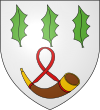Clan Burnett
| House of Burnett | |
|---|---|
| Motto | Virescit Vulnere Virtus (Courage Flourishes at a Wound) |
| Profile | |
| Plant badge | A sprig of holly leaves |
| Chief | |
 |
|
| James Comyn Amherst Burnett of Leys, | |
| Chief of the Name and Arms of Burnett, Baron of Kilduthie. | |
| Historic seat | Crathes Castle |
The House of Burnett (Burnet, Burnette, Burnard, Bernard) is a Lowland and Border Scottish family composed of several branches. The Chief of the Name and Arms of Burnett is James Comyn Amherst Burnett of Leys, Baron of Kilduthie. They are from Deeside, near Banchory, in Northeast Scotland. From the early 14th century to the mid 16th century the family occupied a lake dwelling on the Loch of Leys, and resided there or on land near the lake for over 200 years. It is from this lake that the family eventually acquired the designation "of Leys".
It remains uncertain if the name of Burnett is of Saxon or Norman origins. It has been suggested that the name Burnett is derived from the Old French burnete, brunette, which is a diminutive of brun meaning "brown", "dark brown". Another proposed origin of the name is from burnete, a high quality wool cloth originally dyed to a dark brown colour. There is also evidence which suggests that Burnett stems from the English surname of Burnard, a derivative of the Anglo-Saxon name "Beornheard". Spelling variations of the name in early documents show Burnet and Burnard/Bernard being used interchangeably for the same family and at times for the same person. It is likely that the family of de Bernard first came to Scotland with the return of David I of Scotland and that they settled in Roxburghshire.
There is documented evidence of the family of Burnard in England from the Norman Conquest in 1066, but not before. These are found in the Domesday Book, the Chartulary of St Neots Priory and in charters concerning the Waltham Abbey. Roger Burnard was the Domesday tenant of Alrichesey and also held a manor in Rodedie hundred, Hampshire and the manors of Celdretone and Coteford in Wiltshire; all of which were held of William De Ow. He, his wife Margaret and his son Odo were named in several charters of St. Neot's and in one there is a mention of a daughter, Magilia Burnard. Among the English who came north in the train of David I of Scotland were Burnards who settled in the County of Roxburgh and owned the considerable barony of Farningdoun (aka. Fairnington). They were benefactors of Melrose Abbey and other religious houses. They soon move on to the Northeast of Scotland, where Alexander Burnard settled near Banchory. This Alexander Burnard is considered "The first of the Deeside Burnards, or Burnetts as they were later called".
...
Wikipedia
